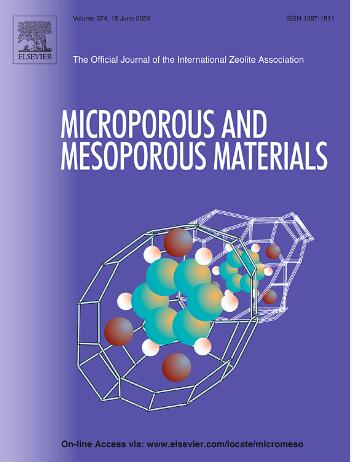Zeolite structure directing agents based upon bulky pyridinium molecules
IF 4.8
3区 材料科学
Q1 CHEMISTRY, APPLIED
引用次数: 0
Abstract
We report new zeolite frameworks synthesized with bulky pyridinium molecules as structure directing agents (SDAs). Aluminosilicate zeolite EMM-63 is prepared in potassium-containing hydroxide media with N,2,3,5-tetramethypyridinium or its skeletal isomer N,2,4,6-tetramethylpyridinium. Two new zeolites (EMM-64 and EMM-65) are prepared with 1-methyl-6,7-dihydro-5H-cyclopenta[b]pyridin-1-ium. EMM-64 is crystallized in fluoride media with or without aluminum, and EMM-65 is prepared as a borosilicate in hydroxide media. The same SDA molecule can be used to prepare an aluminosilicate with the RTH topology, a framework with large cavities and an 8 × 8 channel system. Within each RTH cavity, two SDA molecules form a dimer that is not pi-stacked but instead packs with each pyridinium ring interacting with the unsaturated C5 ring of the neighboring molecule. These interactions optimize the van der Waals interactions both within the dimer and between the dimer and the zeolite framework. The diffraction data of EMM-64 are indexed in tetragonal space group I4122 or I4322 with unit cell dimensions a = 13.8 Å and c = 18.0 Å, and the unit cell composition is |C9NH12F0.9|4Si64O128. The dense framework structure of EMM-64 possesses a tortuous 3D 8R channel system and is unusual in that the framework is chiral. EMM-64 possesses a 51284 cavity with a flat shape like that of the occluded SDA molecule. The fluoride is sited within the 425462 cages of EMM-64.

基于大体积吡啶分子的沸石结构定向剂
我们报道了用大体积吡啶分子作为结构导向剂(SDAs)合成的新型沸石框架。铝硅酸盐沸石EMM-63是以N,2,3,5-四甲基吡啶或其骨架异构体N,2,4,6-四甲基吡啶为原料,在含钾氢氧化物介质中制备的。以1-甲基-6,7-二氢- 5h -环五吡啶-1-ium为原料制备了两种新型沸石(EMM-64和EMM-65)。EMM-64在含铝或不含铝的氟化物介质中结晶,EMM-65在氢氧化物介质中作为硼硅酸盐制备。同样的SDA分子可以用来制备具有RTH拓扑结构的铝硅酸盐,具有大空腔的框架和8 × 8通道系统。在每个RTH腔内,两个SDA分子形成一个二聚体,该二聚体不是pi堆叠,而是与相邻分子的不饱和C5环相互作用的每个吡啶环相互作用。这些相互作用优化了二聚体内部和二聚体与沸石框架之间的范德华相互作用。EMM-64的衍射数据索引在四边形空间群I4122或I4322中,单元格尺寸a = 13.8 Å和c = 18.0 Å,单元格组成为|C9NH12F0.9|4Si64O128。EMM-64的致密骨架结构具有弯曲的3D 8R通道系统,其不寻常之处在于骨架具有手性。EMM-64具有51284的空腔,其形状与闭塞的SDA分子相似。氟化物位于EMM-64的425462笼中。
本文章由计算机程序翻译,如有差异,请以英文原文为准。
求助全文
约1分钟内获得全文
求助全文
来源期刊

Microporous and Mesoporous Materials
化学-材料科学:综合
CiteScore
10.70
自引率
5.80%
发文量
649
审稿时长
26 days
期刊介绍:
Microporous and Mesoporous Materials covers novel and significant aspects of porous solids classified as either microporous (pore size up to 2 nm) or mesoporous (pore size 2 to 50 nm). The porosity should have a specific impact on the material properties or application. Typical examples are zeolites and zeolite-like materials, pillared materials, clathrasils and clathrates, carbon molecular sieves, ordered mesoporous materials, organic/inorganic porous hybrid materials, or porous metal oxides. Both natural and synthetic porous materials are within the scope of the journal.
Topics which are particularly of interest include:
All aspects of natural microporous and mesoporous solids
The synthesis of crystalline or amorphous porous materials
The physico-chemical characterization of microporous and mesoporous solids, especially spectroscopic and microscopic
The modification of microporous and mesoporous solids, for example by ion exchange or solid-state reactions
All topics related to diffusion of mobile species in the pores of microporous and mesoporous materials
Adsorption (and other separation techniques) using microporous or mesoporous adsorbents
Catalysis by microporous and mesoporous materials
Host/guest interactions
Theoretical chemistry and modelling of host/guest interactions
All topics related to the application of microporous and mesoporous materials in industrial catalysis, separation technology, environmental protection, electrochemistry, membranes, sensors, optical devices, etc.
 求助内容:
求助内容: 应助结果提醒方式:
应助结果提醒方式:


